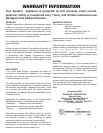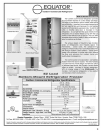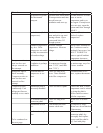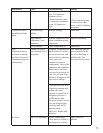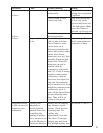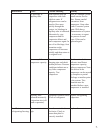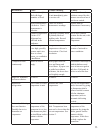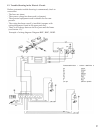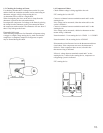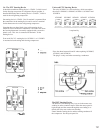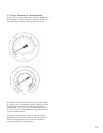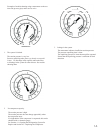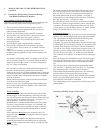
Disturbance Cause Trouble-shooting Remedy
Unit has recently been
filled with large
quantities of food.
Question user about use
of unit immediately prior
to service call.
Inform user about the
problems caused by this.
Instruct user about use of
fast-freeze switch.
Built-in thermometer
is defective. User’s
thermometer is
defective.
Check for correct
thermometer readings.
Replace built-in
thermometer if necessary.
Ambient temperature
is below 0°C.
refrigerant has
collected in the
condenser.
Symptoms resemble those
of partially blocked
capillary tube. Record
ambient temperature.
Findamoresuitable
location for the unit, with
higher ambient
temperature.
Ambient temperature
is too high, possibly
because unit is too
close to a heat
source, or ventilation
is insufficient.
Compare exact
temperature with user’s
observations. Check air
circulation.
Arrange for better
location of unit and/or
better ventilation.
Compressor runs
continuously.
Doors do not fit
snugly.
Insert paper between
door and frame and
closed door. If paper can
be pulled out without
resistance, the door does
not fit tightly enough.
Fold double-sided tape to
suitable thickness and
press in between gasket
and door. Pullgently in
gasket at relevant area.
Rapid ice formation
on freezer shelves.
As above. As above. As above.
Insufficient
refrigeration.
User wishes to lower
temperature in unit.
Measure the exact
temperature.
The cut-out temperature
can be lowered by giving
the thermostat phial a
reduced surface contact
with the aluminum
evaporator (refer to
automatic defrosting
section).
Automatic defrosting
does not function.
Possibly due to ice
formation on
evaporator.
The cut-in
temperature of the
thermostat is too low.
The thermostat phial
has insufficient surface
contact with the
evaporator.
Measure temperature at
phial. Temperature here
must not be lower than the
cut-out temperature. See
Section 2.
Increase the cut-in
temperature of the
thermostat by giving the
phial a greater surface
contact with the
evaporator. If this does
not help, replace the
thermostat.
8.




